Download Asterope Worksheets
Click the button below to get instant access to these premium worksheets for use in the classroom or at a home.
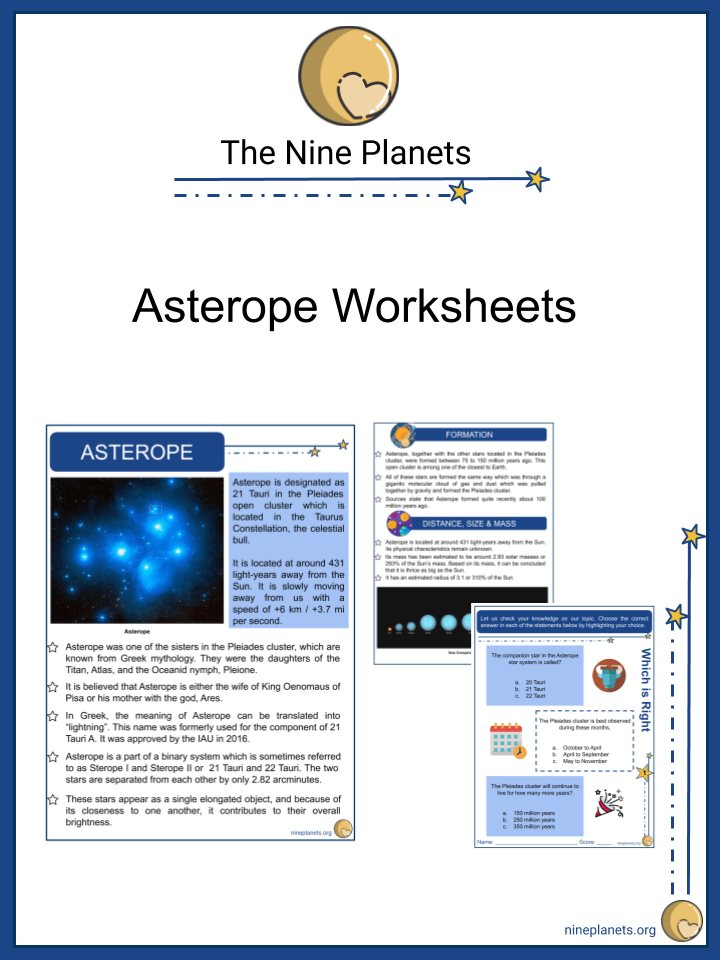
This worksheet can be edited by Premium members using the free Google Slides online software. Click the Edit button above to get started.
Download free sample
Not ready to purchase a subscription yet? Click here to download a FREE sample of this worksheet pack.
Resource Examples
Click any of the example images below to view a larger version.
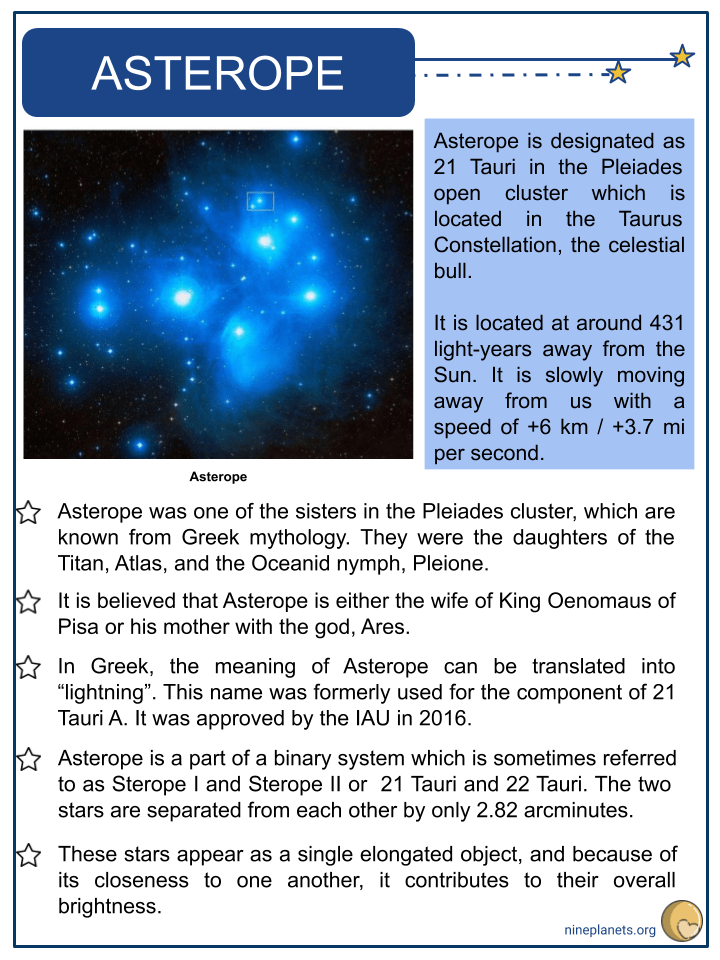
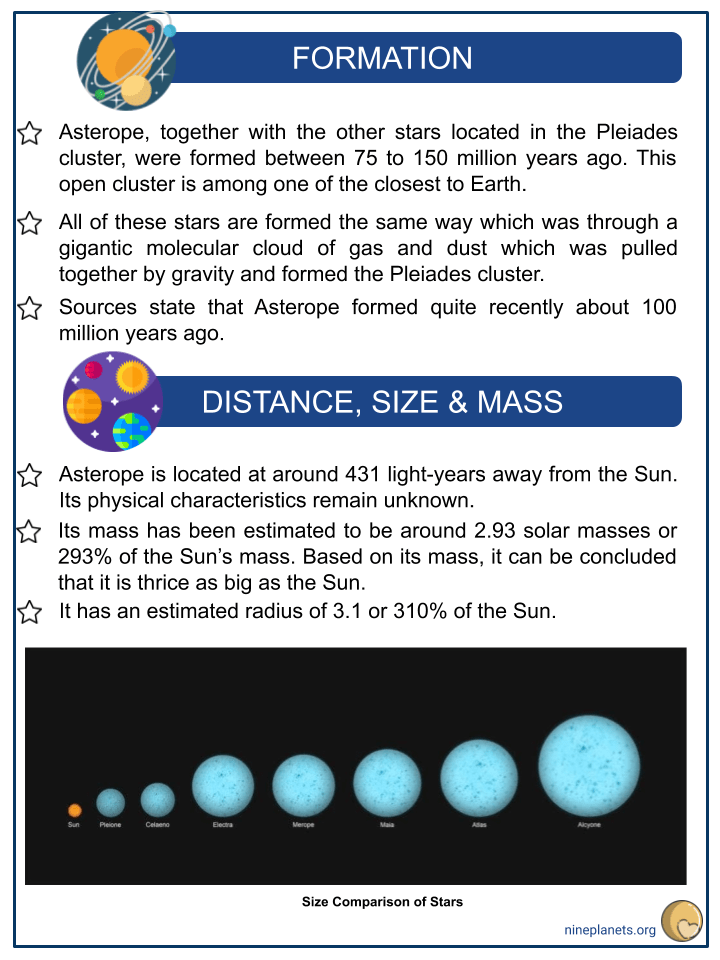
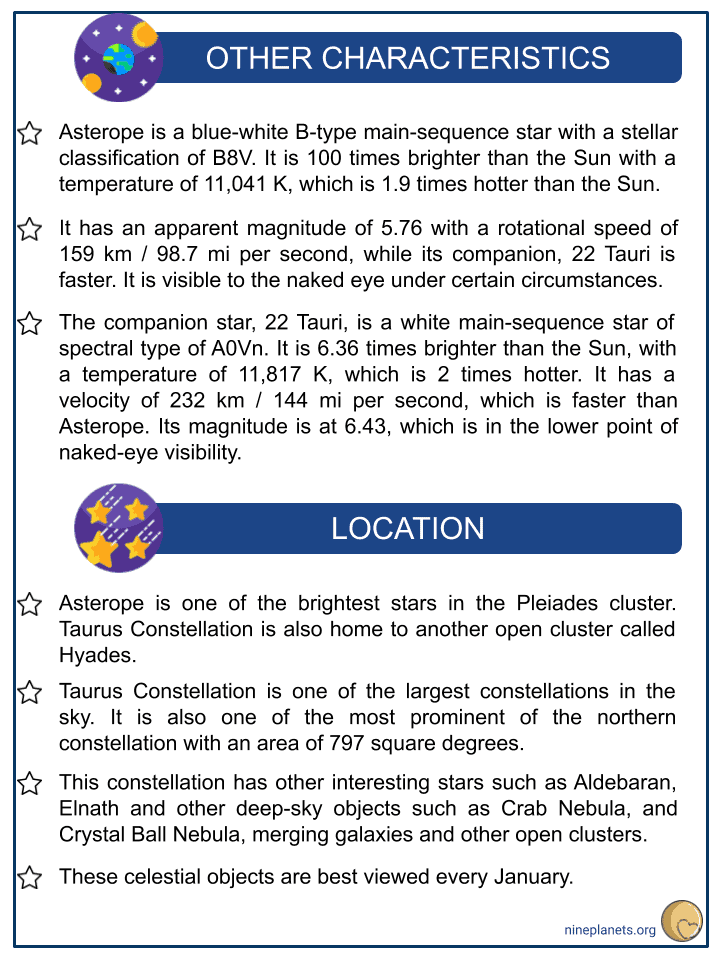
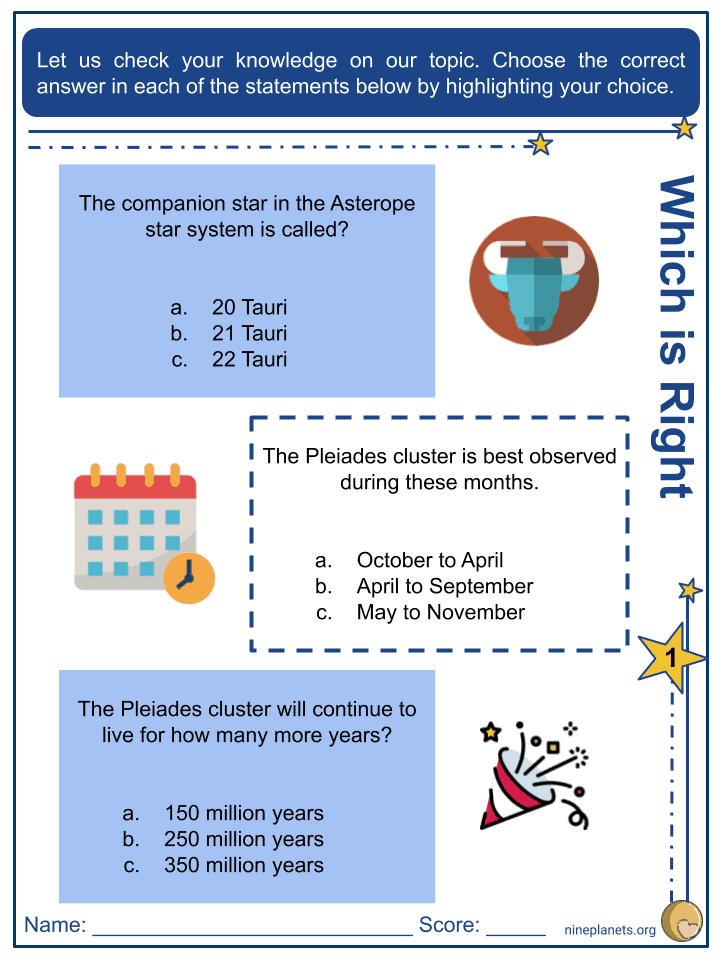
Key Facts & Information
- Asterope is designated as 21 Tauri in the Pleiades open cluster which is located in the Taurus Constellation, the celestial bull.
- It is located at around 431 light-years away from the Sun. It is slowly moving away from us with a speed of +6 km / +3.7 mi per second.
- Asterope was one of the sisters in the Pleiades cluster, which are known from Greek mythology. They were the daughters of the Titan, Atlas, and the Oceanid nymph, Pleione.
- It is believed that Asterope is either the wife of King Oenomaus of Pisa or his mother with the god, Ares.
- In Greek, the meaning of Asterope can be translated into “lightning”. This name was formerly used for the component of 21 Tauri A. It was approved by the IAU in 2016.
- Asterope is a part of a binary system which is sometimes referred to as Sterope I and Sterope II or 21 Tauri and 22 Tauri. The two stars are separated from each other by only 2.82 arcminutes.
- These stars appear as a single elongated object, and because of its closeness to one another, it contributes to their overall brightness.
Formation
- Asterope, together with the other stars located in the Pleiades cluster, were formed between 75 to 150 million years ago. This open cluster is among one of the closest to Earth.
- All of these stars are formed the same way which was through a gigantic molecular cloud of gas and dust which was pulled together by gravity and formed the Pleiades cluster.
- Sources state that Asterope formed quite recently about 100 million years ago.
Distance, Size & Mass
- Asterope is located at around 431 light-years away from the Sun. Its physical characteristics remain unknown.
- Its mass has been estimated to be around 2.93 solar masses or 293% of the Sun’s mass. Based on its mass, it can be concluded that it is thrice as big as the Sun.
- It has an estimated radius of 3.1 or 310% of the Sun.
Other Characteristics
- Asterope is a blue-white B-type main-sequence star with a stellar classification of B8V. It is 100 times brighter than the Sun with a temperature of 11,041 K, which is 1.9 times hotter than the Sun.
- It has an apparent magnitude of 5.76 with a rotational speed of 159 km / 98.7 mi per second, while its companion, 22 Tauri is faster. It is visible to the naked eye under certain circumstances.
- The companion star, 22 Tauri, is a white main-sequence star of spectral type of A0Vn. It is 6.36 times brighter than the Sun, with a temperature of 11,817 K, which is 2 times hotter. It has a velocity of 232 km / 144 mi per second, which is faster than Asterope. Its magnitude is at 6.43, which is in the lower point of naked-eye visibility.
Location
- Asterope is one of the brightest stars in the Pleiades cluster. Taurus Constellation is also home to another open cluster called Hyades.
- Taurus Constellation is one of the largest constellations in the sky. It is also one of the most prominent of the northern constellation with an area of 797 square degrees.
- This constellation has other interesting stars such as Aldebaran, Elnath and other deep-sky objects such as Crab Nebula, and Crystal Ball Nebula, merging galaxies and other open clusters.
- These celestial objects are best viewed every January.
Pleiades Member
- The Pleiades cluster is best observed from October to April, but May and June are not suitable for for observation because it is too close to the Sun.
- This cluster is the brightest in our vicinity. It is easy to find this cluster because of its brightness, but you can also identify its location by drawing a line from the stars of Orion’s Belt – Alnitak, Alnilam, and Mintaka, then past Aldebaran.
- It is also known as Messier 45. Most of the brightest and hottest stars in this cluster are of Spectral Class B and formed between 75 to 150 million years ago.
- Most of the stars are far from each other and located around 444 light-years away from the the Earth. The brightest stars in this cluster are all named after the mythological Seven Sisters and their parents.
- The nine stars in this cluster are Alcyone, Asterope, Atlas, Electra, Celaeno, Maia, Merope, Taygeta, and Pleione. The story is about the seven sisters who were pursued by Orion who is a giant huntsman. Atlas was condemned to carry the heavens on his shoulders due to all his fights with the other gods, while Orion pursued his daughters.
- Zeus stepped in and transformed the sisters into doves, then eventually into stars to console their father. Even if this already happened, it can still be seen that Orion is still pursuing the sisters represented by the Orion Constellation.
The Future
- Asterope will continue to exist after a million a years. However, the Pleiades cluster is seen to have a grim future. It is believed that the cluster will continue to live for 250 million years before it will disperse because of a gravitational interactions with its galactic neighborhood.
Did You Know?
- Chinese people refer to Asterope as the Third Star of Hairy Head. Hairy Head is an asterism formed by the Pleiades stars. It is one of the Seven Mansions of the White Tiger.
- The Pleiades cluster is said to have been formed due to a compact configuration the resembled the Orion Nebula.
- The Pleiades cluster is known by many cultures. The earliest depiction of this cluster and its stars resides in the Nebra sky disk, a Bronze artifact dating to 1,6000 BCE which was uncovered in Germany.
- Many famous books mentioned the cluster like, Homer’s Iliad and Odyssey, Hesiod’s Work and Days, the Bible, the Ancient Egyptian Calendar of the Lucky and Unlucky Days, and the Japanese Kojiki, an account of ancient matters.
- The Pleiades cluster is mentioned in the Kojiki as Mutsuraboshi, which means six stars. In modern Japan, it is presently known as Subaru. It is the same name that is used by the famous automobile company that shows the six bright stars in its logo.
- One of the first telescopic observations conducted on Pleiades was done by Galileo Galilei in 1610. He observed the bright stars and the cluster